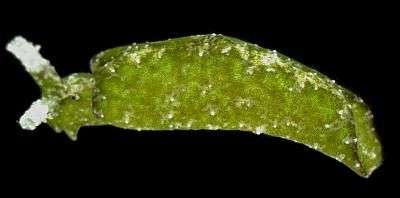September 1, 2015 report
Sea slug found to track seaweed by sniffing its defensive chemicals

(Phys.org)—A team of researchers with the Georgia Institute of Technology has found that one species of sea slug (Elysia tuca) uses chemicals produced defensively by one type of seaweed (Halimeda incrassata) to track down the seaweed. In their paper published in Proceedings of the National Academy of Sciences, the group describes their study and other behaviors of both the slugs and seaweed they observed.
The researchers conducted a series of lab and field experiments to monitor slug and seaweed interactions, and to gather information about the chemicals that came into play. In so doing, they discovered that the slugs were able to track down the seaweed they were looking for by detecting the chemicals that the seaweed normally uses to deflect predators, halimedatetraacetate and 4-hydroxybenzoic acid. They then learned that the slug stabs the seaweed with an appendage called the radula, which it also uses to suck out cytoplasm. Doing so allowed the slugs to obtain energy from the sun, as is normally done with plants—it also provided 60 percent of its carbon intake. As if all that were not enough, the slugs also grabbed some of the halimedatetraacetate and used it as a means for warding off prey. Tracking and preying on the seaweed, the team reports caused an increase in slug population by 12 to 18 fold even though the slugs used the plants to help with their own reproduction efforts only on average for 36 hours.
The researchers report that this is the first instance of the identification of a marine organism mining chemical compounds from an herbivore. They noted that the seaweed did not submit to the invasion without putting up a fight, however, the plants dropped branches where the slugs had attached, severing the relationship between them. The move also likely helped the plant avoid fungal infection, the researchers note. Such branch dropping, they added, led to a reduction in overall growth of the seaweed plant by approximately 50 percent on average.
The team also note that such behavior has been seen in terrestrial ecosystems, which they suggest is interesting because prior studies have shown that terrestrial and marine herbivores split from a common ancestor approximately 400 million years ago, implying that such abilities evolved separately.
More information: Marine and terrestrial herbivores display convergent chemical ecology despite 400 million years of independent evolution, Douglas B. Rasher, DOI: 10.1073/pnas.1508133112
Abstract
Chemical cues regulate key ecological interactions in marine and terrestrial ecosystems. They are particularly important in terrestrial plant–herbivore interactions, where they mediate both herbivore foraging and plant defense. Although well described for terrestrial interactions, the identity and ecological importance of herbivore foraging cues in marine ecosystems remain unknown. Here we show that the specialist gastropod Elysia tuca hunts its seaweed prey, Halimeda incrassata, by tracking 4-hydroxybenzoic acid to find vegetative prey and the defensive metabolite halimedatetraacetate to find reproductive prey. Foraging cues were predicted to be polar compounds but instead were nonpolar secondary metabolites similar to those used by specialist terrestrial insects. Tracking halimedatetraacetate enables Elysia to increase in abundance by 12- to 18-fold on reproductive Halimeda, despite reproduction in Halimeda being rare and lasting for only ∼36 h. Elysia swarm to reproductive Halimeda where they consume the alga's gametes, which are resource rich but are chemically defended from most consumers. Elysia sequester functional chloroplasts and halimedatetraacetate from Halimeda to become photosynthetic and chemically defended. Feeding by Elysia suppresses the growth of vegetative Halimeda by ∼50%. Halimeda responds by dropping branches occupied by Elysia, apparently to prevent fungal infection associated with Elysia feeding. Elysia is remarkably similar to some terrestrial insects, not only in its hunting strategy, but also its feeding method, defense tactics, and effects on prey behavior and performance. Such striking parallels indicate that specialist herbivores in marine and terrestrial systems can evolve convergent ecological strategies despite 400 million years of independent evolution in vastly different habitats.
Journal information: Proceedings of the National Academy of Sciences
© 2015 Phys.org


















